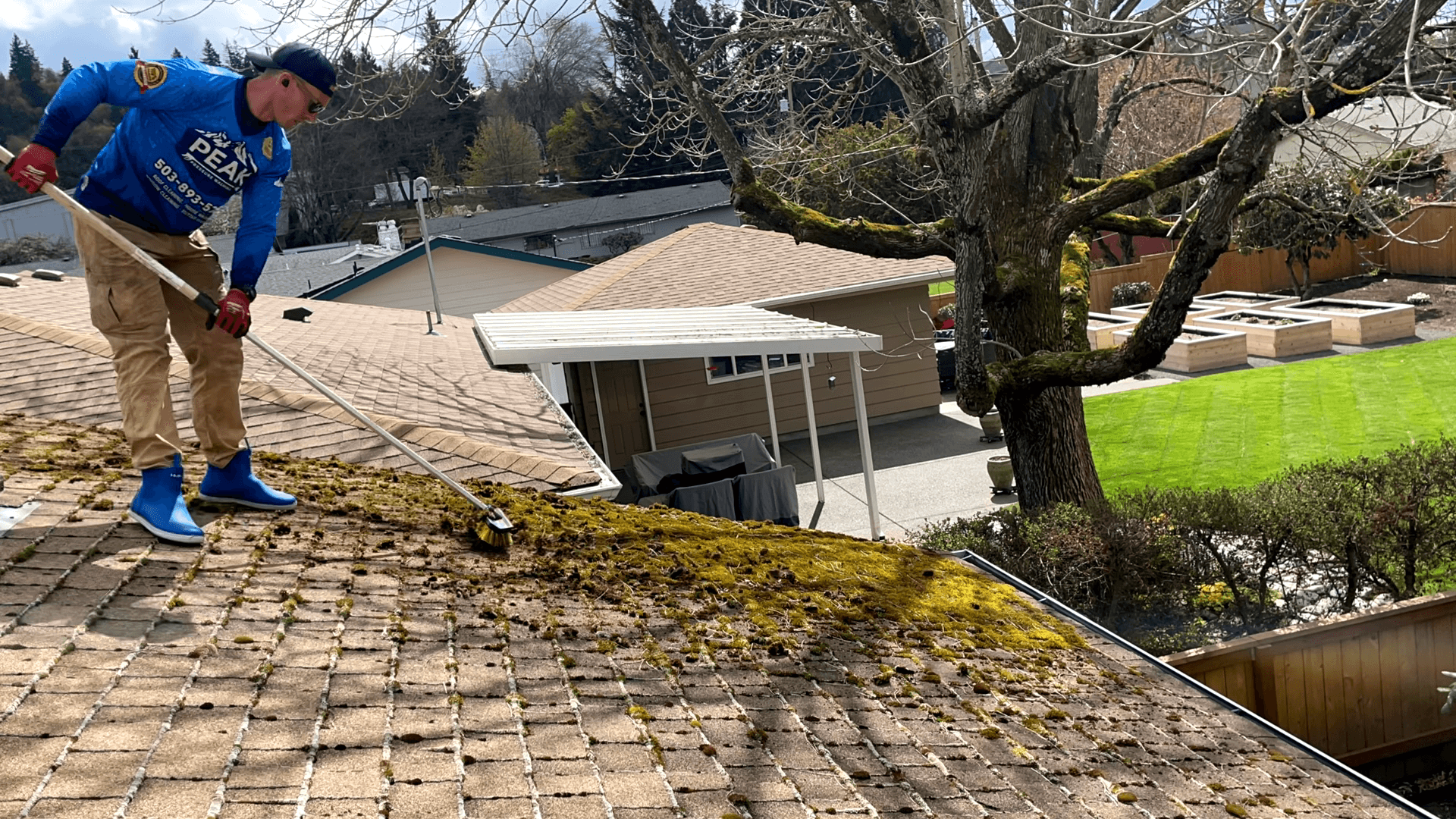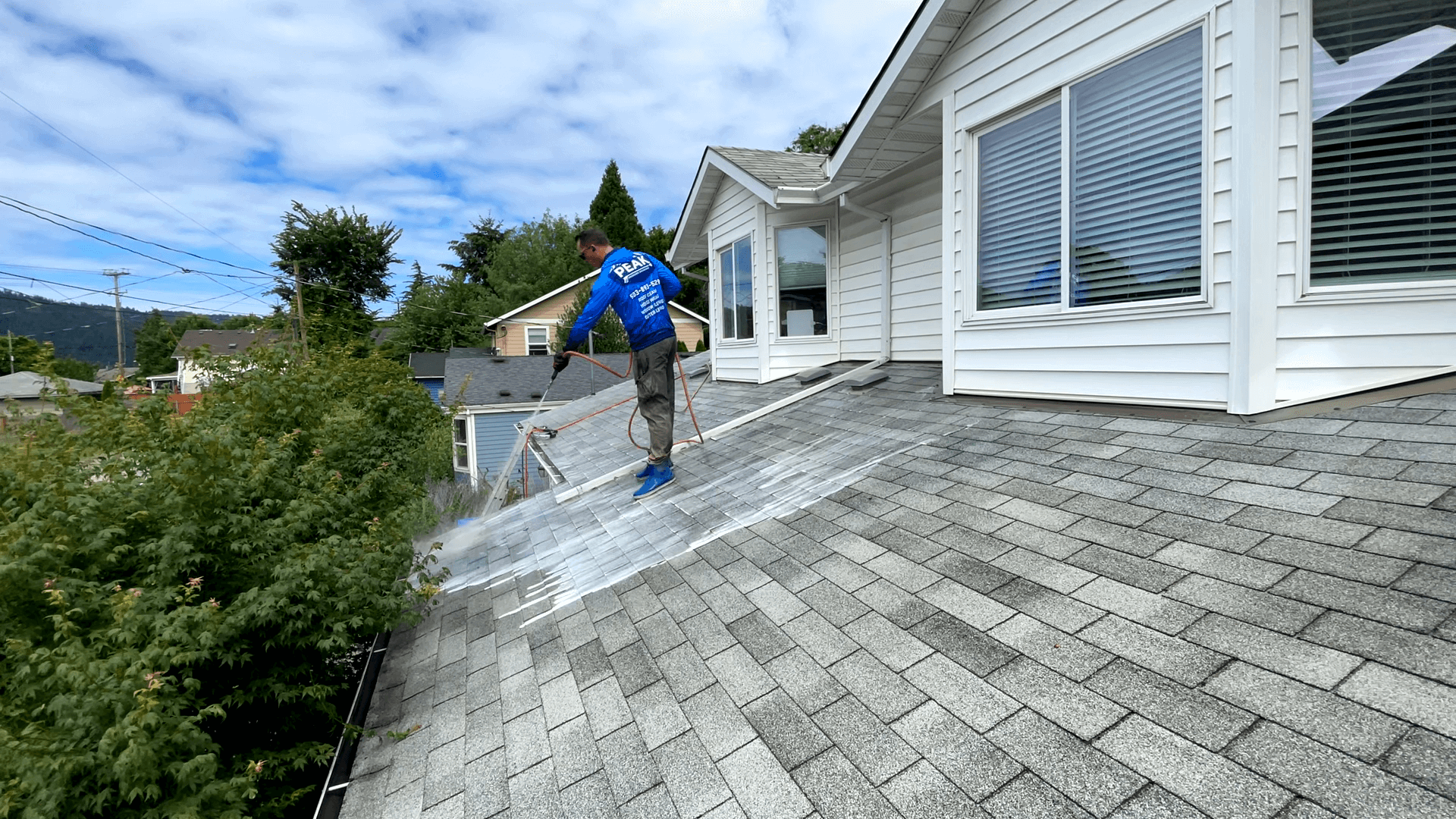Safeguarding your home against the seemingly subtle but resilient presence of moss requires a blend of vigilance and proactive measures. As a natural survivor, moss thrives in damp and shaded environments, often finding cozy spots on your roof or patio. Understanding how to prevent moss from making itself at home is crucial. Begin by regularly inspecting moisture-prone areas, such as roofs, walls, and garden paths, for any early signs of moss. Ensure proper drainage around your home to divert water away, thereby reducing damp conditions that invite moss. Trimming back overhanging trees can minimize shade and, subsequently, the growth of moss.
You’re encouraged to incorporate effective strategies, including professional moss cleaning services or solutions tailored for long-term moss removal. If desired, select materials for outdoor surfaces that resist moss, and when the first signs appear, consider pressure washing to rid surfaces of moss effectively. Learning how to clean moss yourself or consulting with experts on the best ways to get rid of moss could arm you with the necessary skills to maintain a moss-free environment. Proactively engaging these methods in your routine helps ensure that moss invasion remains a minimal concern in your living spaces.
Understanding Why Moss Grows Indoors
In exploring the reasons behind moss growth inside your home, it’s important to recognize that moisture and humidity are the primary culprits. Moss can thrive in areas like basements, bathrooms, and poorly ventilated spaces where damp conditions persist. Leaks in plumbing or roofing further exacerbate the issue, creating an ideal environment for moss to flourish. The lack of adequate sunlight indoors can also contribute, as moss prefers shady and dimly lit locations.
One of the difficulties with indoor moss presence is its inconspicuous nature, which can lead to unnoticed spread until it becomes a larger problem. You can mitigate this by ensuring your home has good ventilation and addressing leaks promptly. Using dehumidifiers to control indoor moisture levels is another beneficial strategy. In some cases, employing professional moss cleaning solutions such as moss-specific detergents can be an effective line of attack. Additionally, maintaining a regular cleaning schedule can prevent the conditions that allow moss to thrive. These solutions aim to not only rid your home of existing moss but also create a less hospitable environment for future growth, making them the best ways to get rid of unwanted moss guests indoors.
Identifying Common Indoor Areas Prone to Moss
Bathrooms, with their naturally humid environments and frequent exposure to water, are breeding grounds for moss. The constant cycle of moisture from showers or baths means that, unless properly ventilated, moss can easily take hold on walls or ceilings. Regular cleaning and checking for leaks can help in moss removal from these spaces, setting a preventative measure against future growth.
Basements are another inviting environment for moss, due to their below-ground level positioning. The inherent dampness often found in basements, combined with minimal sunlight exposure, creates a favorable setting for moss development. Installing dehumidifiers and ensuring adequate light can help mitigate this issue, offering one of the best ways to get rid of moss naturally.
Kitchens can also harbor moss if care isn’t taken with ventilation and moisture control. Steam from cooking without adequate venting can lead to moisture accumulation on walls and surfaces, inviting moss. Keeping vents clean and ensuring good airflow can prevent this potential risk.
In the coming years, advancements in home ventilation systems and moss-resistant materials are likely to reduce the frequency with which indoor moss appears. However, maintaining vigilance and employing professional moss cleaning services when necessary will continue to be crucial in managing moss within houses effectively.
Effective Tips to Prevent Moss Indoors
What steps can you take to keep moss from invading your indoor spaces? Implementing several practical measures can effectively reduce the risk of moss setting up residence inside your home. Start by controlling humidity levels, which is key to making your home an unwelcome environment for moss. Utilizing dehumidifiers in damp areas and ensuring good ventilation will help maintain the dry conditions moss dislikes.
Regular maintenance and cleaning are pivotal. By routinely checking and repairing leaks in plumbing or roofing, you eliminate potential moss-friendly dampness. Mold and moss removal become much easier when you address moisture issues at their source. Adopting a cleaning schedule that focuses on areas prone to moisture can prevent the environment that facilitates moss growth.
Consider the contribution of natural light and airflow. Opening windows and doors to allow sunlight in and fresh air to circulate can significantly discourage moss development. Replacing heavy drapes with sheer curtains in darker rooms will also help. Ensuring airflow in musty areas not only limits moss but enhances the overall freshness of your home.
In certain cases, professional moss cleaning services might be necessary, especially if moss has already taken hold. Experts can provide moss cleaning solutions tailored to your specific situation, ensuring thorough removal and future protection. Additionally, utilizing pressure washing moss from outdoor surfaces adjoining your home can prevent its spread indoors.
By adopting these strategies, you create a home environment that is actively resistant to moss, minimizing its chances of becoming a recurring issue. Maintaining these preventative actions can spare you the hassle and cost of extensive moss removal in the future, providing peace of mind and a healthier living space.
Removing Moss from Surfaces Safely
Removing moss from surfaces safely requires careful consideration of methods and materials. Manual removal with a scrub brush and water is a straightforward option that minimizes the risk of damage. Yet, on the other hand, some homeowners prefer the efficiency of chemical moss cleaning solutions, which can offer more thorough cleaning but might raise concerns about their environmental impact and safety.
For more persistent moss, pressure washing is an effective technique that can quickly clear moss from larger or hard-to-reach areas. While this method offers time-saving benefits, it contrasts with the more delicate approach of hand-cleaning, which reduces the risk of damaging sensitive surfaces. Each method has its merits and the choice often depends on the specific situation and surface involved.
Hiring moss cleaning services provides a professional touch, combining both safety and efficacy. These experts can balance the contrasting needs for thorough moss removal and surface preservation. Consulting with professionals ensures that you employ the best ways to get rid of moss while protecting your household items and minimizing the risk of recurrence. This contrasting perspective aligns with maintaining a moss-free home environment while considering safety as a priority.
Choosing the Right Tools for Moss Removal
Having the appropriate tools for moss removal can make the process more effective and less time-consuming. One essential tool is a sturdy scrub brush with stiff bristles, ideal for detaching moss from flat surfaces without scraping it. For example, when cleaning moss off wooden decks, a brush of this sort can efficiently remove the growth while preserving the integrity of the wood.
A garden hose with a high-pressure nozzle serves as a practical option for rinsing moss away after scrubbing. While not as powerful as a power washer, it provides enough pressure to clear away loose moss and residues. For areas requiring more force, consider pressure washing for moss removal, but use it with caution to avoid damage to more delicate surfaces like clay tiles.
When dealing with extensive moss coverage, a chemical moss treatment may be warranted. Moss cleaning solutions can be applied to stubborn patches, helping to break down the moss for easier removal. Ensure that you select products labeled as safe for the material you are treating to prevent potential surface damage.
For those preferring hands-off cleaning, moss cleaning services can be a suitable option. Professionals come equipped with specialized tools and solutions that address moss in house settings effectively. This allows you to access expert knowledge on how to prevent moss from returning, saving both effort and long-term maintenance costs.
Choosing the right tools not only streamlines the moss removal process but also ensures the safety and longevity of your indoor and outdoor surfaces. Having these tools ready can make your moss-free goals achievable with less effort and greater success.
Natural Remedies for Moss Control
Natural remedies for moss control have roots in history, where simple, everyday substances were employed to tackle this resilient plant long before synthetic solutions were available. Tracing its evolution from medieval times, vinegar has been a trusted agent for its acidic properties, which effectively kill moss on contact. Spraying a mixture of vinegar and water onto affected areas provides an environmentally friendly and cost-effective approach to moss removal, without impacting the surrounding flora.
Baking soda is another traditional remedy that has endured through time, popular for its alkaline nature that disrupts the acidic environment moss thrives in. Sprinkling baking soda on mossy areas and gently scrubbing after some time can help lift the unwanted growth. Saltwater solutions have been documented as a historical method too, serving as an abrasive that hinders moss development and prevents its reoccurrence. These natural methods, while tracing back to older practices, continue to provide answers to concerns about how to clean moss safely in today’s eco-conscious world.





